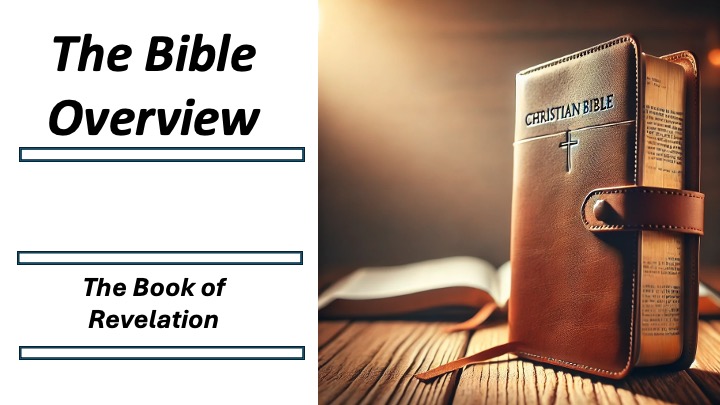Bible Overview Revelation
Mike Ervin

Bible Overview: The Book of
Revelation
Authorship
Traditional View:
• Written by John the Apostle, also known as John of Patmos (Revelation 1:1,
1:9).
• Early church fathers, such as Justin Martyr, Irenaeus, and Tertullian,
support Johannine authorship.
Modern Scholarly View:
• Some scholars argue that John of Patmos was a different John from the
apostle, based on differences in language and theological emphasis compared to
the Gospel of John and the Johannine Epistles.
• The author was likely a Jewish Christian prophet familiar with apocalyptic
traditions.
Date of Authorship
• Traditional View: Written during the reign of Emperor Domitian (81–96 AD),
around 95–96 AD.
• Modern View: Some scholars propose an earlier date (around 68–70 AD) during
Nero’s reign, linking it to the events of the Jewish-Roman War (66–70 AD) and
the destruction of the Temple.
• Most scholars, however, favor the Domitianic date due to persecution
references (Revelation 1:9, 13:7, 17:6).
Intended Audience
• Addressed to seven churches in Asia Minor (modern-day Turkey) (Revelation
1:4).
• Written to encourage persecuted Christians, warning them against compromise
with Roman imperial power and urging them to remain faithful to Christ.
Major Themes
1. Christ’s Ultimate Victory – Jesus as the triumphant Lamb of God (Revelation
5:6–14).
2. Persecution & Endurance – Encouragement for Christians facing Roman
oppression (Revelation 2–3, 13).
3. The Sovereignty of God – God controls history, and evil will ultimately be
defeated (Revelation 19:6).
4. The Judgment of the Wicked – God’s wrath upon unrepentant nations
(Revelation 6–18).
5. The New Creation – A vision of a new heaven and new earth (Revelation
21–22).
6. Symbolism & Apocalyptic Imagery – Uses vivid symbols (beasts, seals,
trumpets, bowls, etc.) to convey spiritual realities.
Chapter-by-Chapter Summary
I. Introduction & Letters to the Churches (Ch. 1–3)
• Ch. 1 – John’s vision of the glorified Christ.
• Ch. 2–3 – Letters to seven churches (Ephesus, Smyrna, Pergamum, Thyatira,
Sardis, Philadelphia, Laodicea), addressing strengths, weaknesses, and calls to
repentance.
II. Heavenly Throne Room & the Seals (Ch. 4–7)
• Ch. 4 – Vision of God’s throne, worship of the Creator.
• Ch. 5 – The Lamb (Jesus) opens the scroll.
• Ch. 6 – The first six seals (Four Horsemen, martyrdom, cosmic disturbances).
• Ch. 7 – The 144,000 sealed and a great multitude in heaven.
III. The Trumpets & the War in Heaven (Ch. 8–12)
• Ch. 8–9 – The seven trumpets bring plagues, demonic invasion.
• Ch. 10 – The mighty angel and the little scroll.
• Ch. 11 – The two witnesses and the seventh trumpet.
• Ch. 12 – The woman, the dragon (Satan), and the birth of Christ.
IV. The Beasts & Final Judgments (Ch. 13–18)
• Ch. 13 – The Beast from the Sea (Antichrist) and the Beast from the Earth
(False Prophet).
• Ch. 14 – The 144,000 redeemed, judgment announced.
• Ch. 15–16 – The seven bowls of God’s wrath.
• Ch. 17–18 – The fall of Babylon, representing Rome/worldly power.
V. Christ’s Victory & New Creation (Ch. 19–22)
• Ch. 19 – Christ’s return as King, the defeat of the Beast and False Prophet.
• Ch. 20 – Satan’s defeat, the Great White Throne Judgment.
• Ch. 21–22 – The New Heaven & New Earth, New Jerusalem, eternal life.